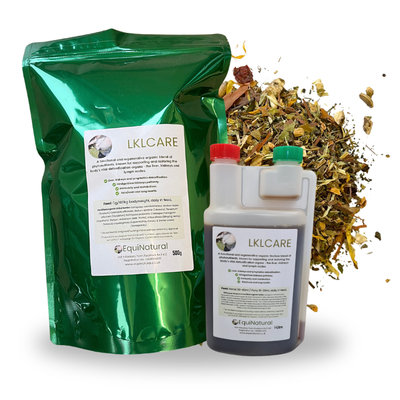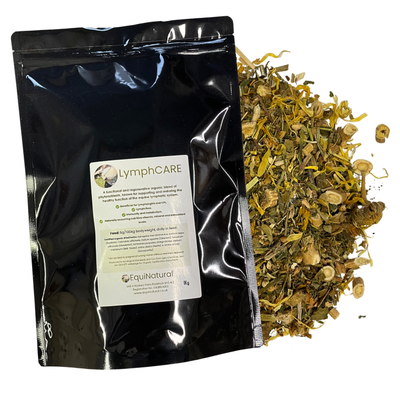CALENDULA (Calendula officinalis)
Available either as a dried herb or herbal tincture.
Please note this is a nutritional, functional horse food supplement and not veterinary medicine.
See Dr Kellon's Horse Sense - 'Nutrition is not 'Alternative' Therapy.
Tincture
Our human-grade, certified organic tinctures give you a ready-to-absorb potent source of phytonutrients at the highest-strength available, for immediate absorption straight into the bloodstream and to the body’s cells.
100% certified organic pure tincture: Calendula officinalis (Marigold) Petals, Cold Macerated 1:3 90% , Organic Cultivated
- Feed Guide
- 6ml/100kg bodyweight, daily in feed.
- Always shake the bottle to disperse any sediment.
- 3-year shelf-life.
Dried Herb
- Certified organic dried herb
Calendula officinalis (Marigold) Flowers , Organic Cultivated, Origin Egypt
- Feed Guide
- 5g/100kg bodyweight per day, thus for an average 500kg horse add 25g daily to feed.
- 1-year shelf-life.
Functional Nutritional Value
Constituents: Flavonoids (including rutin and narcissin), triterpenoid saponins (calendulosides A-D), volatile oil, carotenoids, phenolic acids (chlorogenic acid and coumaric acid), resin, sterols, tannin, amino acids, mucilage, and polysaccharides.
NB. Our range of botanicals are all grown, harvested and dried without the use of agri-chemicals, non-irradiated and GMO free - see our Quality page for Quality Management & Certification Documents. Laboratory tested for identification and compliance to the British and European Pharmacopoeia standards, and are human grade.
Please be aware that if you're purchasing our dried botanicals for human use, our dried range is cut to appropriate sizes for feeding to horses.
More ...
Calendula's sunny yellow and orange flowers were enough to inspire Shakespeare to famously describe it in The Winter’s Tale:
The marigold, that goes to bed wi’ the sun
And with him rises weeping (4.4.125-126).
Calendula, aka marigold, doesn't seem to have been cultivated or at least written about until around the 12th century in Northwestern Europe. German Benedictine abbess and herbalist Hildegard von Bingen (1155/2001) mentioned it, deeming it cold and moist, and useful against poisons both in humans and livestock.
From the 12th to 17th centuries, calendula also had a reputation as a mood enhancer for cheerfulness, in that just gazing at the flower could draw away evil humours from the head. In 1629, herbalist and botanist John Parkinson recorded that it was used in food as well as in syrup or a conserve made from fresh flowers, as a " comforter of the heart and spirits, and to expel any malignant or pestilential quality, gathered near thereunto ", but not much more than this. Meanwhile, recent research (2017) has begun affirming some antidepressant effects in vivo , but these effects have yet to be confirmed in us humans.
Calendula is probably best known for its external use for wounds and skin issues, and a lymphatic supporter. Samuel Hahnemann (1755-1843), the father of homeopathy, added the herb to his homeopathic preparations for topical infections, wounds, sores, and burns. It also appears to have been used for wounds in both the American Civil War and World War I, particularly when other emergency medical supplies had run low.
It's also a potent anti-inflammatory and with its astringent actions combined with its antibacterial, antiviral, and antifungal properties, this make it a common choice for a wide variety of skin issues, having long been used topically to soothe and mend cuts, burns, bites, sprains, bruises, rashes, sunburns and abrasions, including persistent wounds and gangrene, as well as dermatological issues and infestations such as scabies. It's also used both internally and externally for fungal skin infections (i.e. athlete’s foot) and yeast overgrowth (i.e. candida in the gut, thrush, and vaginal yeast infections). Furthermore, its astringent and blood-decongestant actions may arise from its saponins and flavonoids, and accordingly, like horse chestnut ( Aesculus hippocastanum ), may be used for issues such as haemorrhoids and varicose veins.
However, calendula’s anti-inflammatory action goes deeper than its indication for infections or external skin/wound issues - it's thought it can help inflammation related to bone and joint diseases, particularly arthritis. It also appears that its antiviral action may be due to its triterpenoid saponins , which are said to suppress the replication of viruses such as influenza APR-8, influenza A2, and herpes simplex in vitro. Herbalist Julian Barker remarked that he switched to using a lower concentration of 25% alcohol in tinctures for both enhanced antiviral results (because calendula’s water-soluble constituents contribute to its antiviral activity) as well as to ease irritation to delicate stomachs.
Calendula is also commonly used as a lymphagogue - it works well for horses when combined with cleavers - and is known as a blood cleanser or alterative. It cleanses the lymphatic system by moving the lymph, removing toxins from the lymph, and decongesting swollen lymph nodes, as well as improving the circulation of the blood. It's also noted that its ability to help internal drainage from wounds may also indicate its affinity with the lymphatic system and the veins.
Keeping the lymph system moving is vital for a strong immune system, and calendula is also used as an immune tonic, dating back to the 1600s. It's known as a European peasant tonic for the immune system, particularly in winter, as it may remove old, toxic lymphatic congestion and stubborn infections.
Calendula is also a diaphoretic that has long been used for fevers: it's said to warm the system and push fluids to the surface to promote sweating, which helps the body fight off pathogens, subsequently easing fever as well as removing toxins from the body.
Calendula’s slightly bitter taste also hints at its use for the digestive system, said to improve nutrient absorption. It's thought to be useful for gastric ulcers, gastric reflux, IBS, and leaky gut syndrome, with its mucilage content wonderfully soothing to irritated tissues and contributing to its demulcent action, and its antispasmodic actions indicated for constipation and stomach cramps.
Being such a diverse plant, calendula is an easy herb to have around and not just for its phytonutrients. As an edible flower it's used in soups and salads, and in olden days it was used to colour cheese and as a substitute for saffron, as well as a fabric and hair dye ;-)
We use Calendula in many of our Immunity C.A.R.E. blends
, as well as in our DermaClear and SwItch Gels.
Safety
- Calendula should not be used during pregnancy as it has traditionally been used as an emmenagogue and classed as a uterine stimulant.
- If using calendula as a vulnerary, ensure wounds are fully cleaned before application because calendula rapidly repairs tissue.







